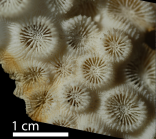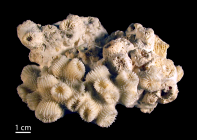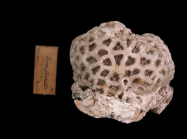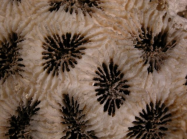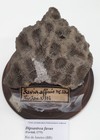
WoRMS taxon detailsDipsastraea Blainville, 1830
718746 (urn:lsid:marinespecies.org:taxname:718746)
accepted
Genus
Madrepora favus Forskål, 1775 accepted as Dipsastraea favus (Forskål, 1775) (type by subsequent designation)
Astraea (Fissicella) Dana, 1846 · unaccepted > junior subjective synonym
Astrea (Dipsastraea) Blainvile, 1830 · unaccepted > superseded combination
Barabattoia Yabe & Sugiyama, 1941 · unaccepted > junior subjective synonym
Bikiniastrea Wells, 1954 · unaccepted > junior subjective synonym
Dipsastrea Blainville, 1830 · unaccepted > misspelling - incorrect subsequent spelling
marine,
recent + fossil
de Blainville, H. M. (1830). Zoophytes. In: Dictionnaire des sciences naturelles, dans lequel on traitre méthodiquement des differéns êtres de la nature, considérés soit en eux-mêmes, d'après l'état actuel de nos connoissances, soit relativement à l'utlité qu'en peuvent retirer la médicine, l'agriculture, le commerce et les arts. Edited by F. G. Levrault. Tome 60. Paris, Le Normat. Pp. 548, pls. 68. <em>Paris, 1830.</em> 60 : 1-546., available online at https://www.biodiversitylibrary.org/page/25318344 [details]
Description 'Plus ou moins globuleuses, formées de loges profondes, infundibuliformes, subpolygonales, à parois communes, à bords...
Description 'Plus ou moins globuleuses, formées de loges profondes, infundibuliformes, subpolygonales, à parois communes, à bords élevés, multisillonnés et échinulés.' (de Blainville, 1830: 338) [details]
Hoeksema, B. W.; Cairns, S. (2025). World List of Scleractinia. Dipsastraea Blainville, 1830. Accessed through: World Register of Marine Species at: https://www.marinespecies.org/aphia.php?p=taxdetails&id=718746 on 2025-05-05
Date action by
Nomenclatureoriginal description
de Blainville, H. M. (1830). Zoophytes. In: Dictionnaire des sciences naturelles, dans lequel on traitre méthodiquement des differéns êtres de la nature, considérés soit en eux-mêmes, d'après l'état actuel de nos connoissances, soit relativement à l'utlité qu'en peuvent retirer la médicine, l'agriculture, le commerce et les arts. Edited by F. G. Levrault. Tome 60. Paris, Le Normat. Pp. 548, pls. 68. <em>Paris, 1830.</em> 60 : 1-546., available online at https://www.biodiversitylibrary.org/page/25318344 [details] original description (of Barabattoia Yabe & Sugiyama, 1941) Yabe H, Sugiyama T. (1941). Recent reef-building corals from Japan and the South Sea Islands under the Japanese mandate. II. <em>The Science reports of the Tôhoku, Imperial University, Sendai, 2nd Series (Geologie).</em> Special Volume 2: 67-91, pls. 60-104. [details] original description (of Bikiniastrea Wells, 1954) Wells JW. (1954). Bikini and nearby atols: 2. Oceanography (biologic). Recent corals of the Marshall Islands. <em>Geological Survey Professional Paper.</em> 260-1: 385-486, pls. 94-185. [details] original description (of Astraea (Fissicella) Dana, 1846) Dana, J.D. (1846-1849). Zoophytes. United States Exploring Expedition during the years 1838-1842. <em>Lea and Blanchard, Philadelphia.</em> 7: 1-740, 61 pls. (1846: 1-120, 709-720; 1848: 121-708, 721-740; 1849: atlas pls. 1-61)., available online at https://www.biodiversitylibrary.org/page/18989497, http://www.sil.si.edu/digitalcollections/usexex/navigation/ScientificText/USExEx19_08select.cfm [details] basis of record Budd AF, Fukami H, Smith ND, Knowlton N. (2012). Taxonomic classification of the reef coral family Mussidae (Cnidaria: Anthozoa: Scleractinia). <em>Zoological Journal of the Linnean Society.</em> 166 (3): 465-529., available online at https://doi.org/10.1111/j.1096-3642.2012.00855.x [details] Otheradditional source
Huang D, Benzoni F, Fukami H, Knowlton N, Smith ND, Budd AF (2014) Taxonomic classification of the reef coral families Merulinidae, Montastraeidae, and Diploastraeidae (Cnidaria: Anthozoa: Scleractinia). Zoological Journal of the Linnean Society 171: 277–355., available online at https://doi.org/10.1111/zoj.12140 [details]
additional source Khalil HM, Fathy MS, Al Sawy SM. (2021). Quaternary corals (Scleractinia: Merulinidae) from the Egyptian and Saudi Arabian Red Sea Coast. <em>Geological Journal.</em> , available online at https://onlinelibrary.wiley.com/doi/10.1002/gj.4145?af=R [details] additional source Wells JW. (1936). The nomenclature and type species of some genera of recent and fossil corals. <em>American Journal of Science.</em> 31: 97-134., available online at https://ajsonline.org/article/61464 [details]  Present Present  Inaccurate Inaccurate  Introduced: alien Introduced: alien  Containing type locality Containing type locality
From editor or global species database
Biology zooxanthellate [details]Comparison No apomorphies for Dipsastraea are consistent across data types, mainly because the nesting of Coelastrea and Trachyphyllia on the molecular tree results in distinguishing features being optimized as plesiomorphic traits. Unequal costosepta is the only synapomorphy on the morphological phylogeny. In spite of this, Dipsastraea can be easily differentiated from the aforementioned close relatives by its moderate amount of coenosteum, 3 cycles of septa and weak to moderate paliform lobes, rather than fused, limited walls or phaceloid colonies, 4 septal cycles, well-developed septal lobes. Thin sections also reveal that Dipsastraea has more distinct costa center clusters but weaker costa and septum medial lines than Coelastrea and Trachyphyllia. Being conventionally grouped with the Atlantic Favia spp. previously, the distinction between Dipsastraea and Favia is much clearer with the characters analyzed here. Even with macromorphology, the differences are substantial, with Dipsastraea possessing larger and deeper corallites (after losing Goniastrea stelligera), fewer and less crowded septa, columellae that are smaller but denser, and paliform (single axis) instead of septal (fan-shaped) lobes. Of the 23 subcorallite characters used, 14 are distinct between them. Aside from the family-level synapomorphies associated with tooth shape, the walls of Dipsastraea are formed primarily by paratheca instead of septotheca as in Favia. This genus is fairly well sampled, but most of the more recently-described species of Veron (2000) are lacking data. [details] Description 'Plus ou moins globuleuses, formées de loges profondes, infundibuliformes, subpolygonales, à parois communes, à bords élevés, multisillonnés et échinulés.' (de Blainville, 1830: 338) [details] Diagnosis Colonial, with intracalicular budding only. Corallites monomorphic and discrete (1–3 centers); monticules absent. Coenosteum costate, moderate amount (< corallite diameter), limited (includes double wall) in some species. Generally, calice width medium (4–15 mm), with medium relief (3–6 mm); few species with wider and/or deeper calice. Costosepta not confluent. Septa in 3 cycles (24–36 septa). Free septa present but generally irregular (regular in D. helianthoides and D. laxa). Septa spaced 6–11 septa per 5 mm. Costosepta equal in relative thickness. Columellae trabecular and spongy (> 3 threads), < 1/4 of calice width, and continuous among adjacent corallites. Paliform (uniaxial) lobes weak or moderate. Epitheca well developed and endotheca low-moderate (tabular). Tooth base at mid-calice circular. Tooth tip at mid-calice irregular; tip orientation perpendicular to septum. Tooth height medium (0.3–0.6 mm) and tooth spacing medium (0.3–1 mm), with > 6 teeth per septum. Granules scattered on septal face; irregular in shape. Interarea palisade. Walls formed by dominant paratheca and partial septotheca; abortive septa absent. Thickening deposits fibrous. Costa center clusters generally strong but highly variable; 0.3–0.6 mm between clusters; medial lines weak. Septum center clusters weak; 0.3–0.5 mm between clusters; medial lines weak. Transverse crosses present. Columella centers clustered. [details] Remark This is a large genus that, prior to Budd et al. (2012), had all its species distributed among Favia Milne Edwards and Haime, 1857, vol. 2: 426 and Barabattoia Yabe and Sugiyama, 1941: 72. It was discovered through molecular phylogenetic analyses that Favia was actually comprised of at least two main lineages separated according to the geographic divisions Indo-Pacific and the Atlantic (Fukami et al., 2004, 2008). Since the type species of Favia is Madrepora fragum Esper, 1795: 79, an Atlantic species (see Hoeksema, Roos and Cadée, 2012), it followed that a taxonomic split of the genus will involve reassigning the Indo-Pacific species into the resurrected genus Dipsastraea de Blainville, 1830: 338. Until the recent revision, Dipsastraea had never been applied since it was established. Wells, 1936: 109 showed that all the species initially assigned to Dipsastraea had been placed in other genera, thus fixing Madrepora favus Forskål, 1775: 132 as the lectotype by elimination, following the transfer of Madrepora favosa Esper, 1795: 34 into Favia (Milne Edwards and Haime, 1857, vol. 2: 443). Matthai, 1914: 79 subsequently moved Madrepora favus Forskål into Favia as well, effectively synonymizing Dipsastraea as Favia. Here, we show that morphologically Madrepora favus Forskål falls well within the large clade of Indo-Pacific Favia, corroborating molecular results that show that these species are closely related (Fukami et al., 2004; Fukami et al., 2008; Huang et al., 2011; Kongjandtre et al., 2012). However, three major issues need to be addressed. First, the synonymy of Barabattoia mirabilis Yabe and Sugiyama, 1941: 72 as B. amicorum by Veron et al., 1977: 32 is untenable, as these are clearly two distinct species. The specimen shown in Veron et al., 1977, fig. 37, is incorrectly referred to as the 'holotype of Favia amicorum'. We have verified that MNHN specimen IK-2010-470 is the holotype of B. amicorum, following the original description in Milne Edwards and Haime, 1849, vol. 12: 171 and illustration in Milne Edwards and Haime, 1848, vol. 10, pl. 9: fig. 9. All the molecular trees used here have essentially followed the taxonomy of Veron et al. (1977) when analysing B. mirabilis. We thus regard them both as valid species, and all molecular terminals identified as B. amicorum to be B. mirabilis that has consistently been placed within the Indo-Pacific Favia clade (Fukami et al., 2008; Huang et al., 2011; Huang, 2012; Arrigoni et al., 2012). Supported by recovery of two Barabattoia spp. (i.e. B. laddi and B. mirabilis) in the same clade on the morphological phylogeny, we consequently consider Barabattoia as a synonym of Dipsastraea. Second, Astrea (Orbicella) stelligera Dana, 1846: 216 and Favites rotundata Veron, Pichon and Wijsman-Best, 1977: 64 are more closely related to Goniastrea and Favites respectively than Favia (or Dipsastraea), and we give separate accounts below based on their phylogenetic affinities. Third, results show that Trachyphyllia geoffroyi (Audouin, 1826: 233), Goniastrea aspera Verrill, 1866: 32, and Favia palauensis Yabe and Sugiyama, 1936: 30 are morphologically distinct from Dipsastraea, but molecular data have often placed these species within the latter (Fukami et al., 2004; Fukami et al., 2008; Huang et al., 2011; Huang, 2012; Arrigoni et al., 2012). On the basis of the morphological evidence and long molecular branch lengths leading to these species, we placed them in two other genera described here (i.e. Trachyphyllia Milne Edwards and Haime, 1848, vol. 27: 492 and Coelastrea Verrill, 1866: 32). [details] Type designation Subsequent designation by Wells (1936) [details]
|
